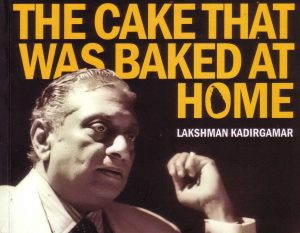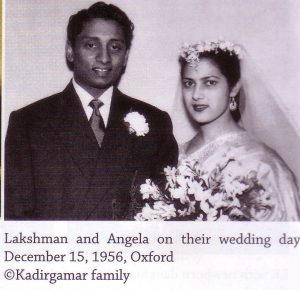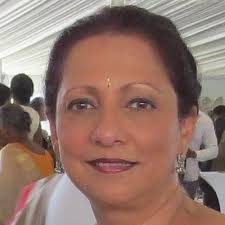by Sachi Sri Kantha, August 10, 2019
Book Review: ‘The Cake that was Baked at Home – Lakshman Kadirgamar, Snapshotsof the Man’s Life and Times by his Daughter’, by Ajita Kadirgamar, Vijitha Yapa Publications, Colombo, 2nd ed., 2016, 522 pages.
Fourteen years had passed since Lakshman Kadirgamar (1932-2005) was assassinated on August 12th. Though the second edition of the book in review appeared in 2016, it’s opportune to revisit Kadirgamar’s record, via this book. In the foreward to the book, Ajitha (the daughter of Lakshman Kadirgamar, born 1959) writes the following:
“Dearest Dada,
….Please don’t expect analytical chronicles about your political achievements, or theoretical discussion on what you would be doing if you were still alive or other such deeply academic matters; that task I leave to the pundits, and lord knows there are enough of those around! This book reflects you – The Man – with your incredible strengths and talents the whole world was privy to on one hand, but also the lesser understood weaknesses, failings and other human foibles that were part of your make up…”

In sum, the book consists of 45 ‘chapters’ (though not indicated as such) in 521 pages, with 554 foot notes, with rarely seen 55-odd photographs, from family album. Among the foot notes, I counted 32 refer to the articles of D.B.S. Jeyaraj in local newspapers. As such, Jeyaraj may deserve a spot as a co-author of this book. Ajitha had tagged him as “LK’s ‘unofficial biographer’”. Lack of an index is a demerit for the book, because, there have been some ‘big name-dropping’ (such as Mahatma Gandhi, Richard Nixon, Ava Gardner, Colin Powell, Liam Fox of international variety). Some little known facts about Kadirgamar’s life presented in the book may be of interest.
Lakshman was the last child to Samuel Kadirgamar and Parimalam Mather, born on April 12, 1932. An age gap of 15 years separated him with his oldest brother Sam. Unfortunately, he lost his mother when he was only 7, in 1939. As such, his elder sister Iswari played the surrogate mother role for him.
Lakshman married for the first time in Dec. 15, 1956. His wife was of French-Pakistani origin, Angela Malik. She was a divorcee. According to the author, “right from the beginning he started to call her ‘kunj’ (‘kunju’ being a Tamil term of endearment), which he continued to do for the next thirty five years.” He divorced her in 1992.
 He married second time in 1996. His wife was Suganthi Wijesuriya, a lawyer. As Ajita writes, “their association dated back to 1978, when she was secretary of the Intellectual Property Law Revision Committee in Sri Lanka…He could remarry not a Tamil woman, but a Sinhala one, which would gain him acceptability in the eyes of the majority Sinhala public….Some immediate family members believe she ‘forced’ herself into LK’s life and that he did not particularly want to marry the woman but needed a ‘Sinhala confidante’ by his side.”
He married second time in 1996. His wife was Suganthi Wijesuriya, a lawyer. As Ajita writes, “their association dated back to 1978, when she was secretary of the Intellectual Property Law Revision Committee in Sri Lanka…He could remarry not a Tamil woman, but a Sinhala one, which would gain him acceptability in the eyes of the majority Sinhala public….Some immediate family members believe she ‘forced’ herself into LK’s life and that he did not particularly want to marry the woman but needed a ‘Sinhala confidante’ by his side.”
He survived the Swissair Flight 316 plane crash at Athens airport on October 7, 1979.
Lakshman also had a kidney transplant operation in New Delhi in 2000. The donor was a 34 year old Buddhist monk, Balangoda Mahanama Thera.
I was a bit surprised to find the name Nadesan Satyendra mentioned once, through the mouth of Kadirgamar’s personal secretary Wilson Ramanujam. “Even his ferocious opposing Labour lawyers like Nadesan Satyendra and Bala Tampoe respected LK very much and they were friends outside the legal arena, which shows what a fair, decent and caring man he was.” (p. 133). Well, in the battle fields of courts, Satyendra would have respected Kadirgamar’s acumen. But, I’m sure, that he would have resented Kadirgamar’s sycophancy to Sinhalese ruling class. I provide my proof.
My Critique on Kadirgamar in the ‘Tamil Nation’ website of Satyendra
The Tamil Nation website (now defunct) established and edited by Satyendra carried my critique of Kadirgamar’s politics ‘Sin-eaters and Snollygosters’ in October 4, 2000. Presidential sibling Anura Bandaranaike (then belonging to the UNP) also had received one mention, without providing clear context to the flippant rebuttal he had received from Kadirgamar’s tongue – ‘The Honourable Member is talking bovine excrement’. In my 2000 critique, I had provided the context for it. Thus, I provide excerpts of this critique below.

Ajita Kadirgamar
“According to Brewster’s Dictonary of Phrase and Fable, sin-eaters were the poor persons hired at funerals in Medieval Times, to eat beside the corpse and so take upon themselves the sins of the diseased, that the soul might be delivered from Purgatory. This tradition of sin-eating has been recorded in England, Ireland, Wales, Eastern Europe and even in India. Though there may be cultural variation, a unifying theme of this job is that, the sin-eaters are poor persons, and because they take others’ sins on to themselves, they are generally viewed as unclean and stand outside the general community.
Lakshman Kadirgamar has been functioning as a sin-eater for SLFP in general, and for Chandrika Kumaratunga in particular, since 1994. He is a poor person, not in material wealth or academic qualifications, but in ethnic pride. So, he is generally viewed as unclean and stand outside the Tamil community. This is well known to SLFPers as well.
In a verbal onslaught delivered in the Sri Lankan parliament, almost an year ago, none other than Anura Bandaranaike thrashed Kadirgamar’s bloated ego with the following lines:
‘Can Minister Kadirgamar get ten votes anywhere in this country? Can he walk along Wellawatta? No. Can he get five Tamil votes either in Colombo, or in the North? I challenge him to contest the next general elections and we can then judge his standing in this country. Can he travel beyond Anuradhapura? Has he been to see the plight of his fellow Tamils, in Jaffna or elsewhere?
He says I look for cheap headlines. It is Minister Kadirgamar who seeks the cheapest possible headlines and publicity making a right royal mess of our foreign policy and fool of himself.’
I am no big fan of Anura Bandaranaike. But when it comes to a choice between Kadirgamar and Anura, I would opt for Anura. This is because, despite his deficiencies in academics and politics, he had stood on his legs for over 20 years, and had ‘paid his dues’ as Americans would say. Opposed to Anura, Kadirgamar is a sin-eater for Chandrika, and I completely agree with Anura’s rebuke on Kadirgamar that,
‘such puerile servitude is only possible from a man who has no base and had to desperately hang on to my sister’s sari pota for his sheer political survival, and which no other self respecting cabinet minister does or will do.’
Yes, Kadirgamar has to hand to Chandrika’s sari. But, he has to pay a price for such sari-hanging. As Anura Bandaranaike has stated, Kadirgamar cannot receive a handful of votes on his own anywhere in Sri Lanka. Thus, for nomination into the SLFP’s National List, he works hard as a sin-eater beyond the boundaries of Sri Lanka…”
K.Godage’s cock and bull story on Colin Powell
The book would have gained a lot, if the hyperbole statements of Sinhalese on Kadiragamar’s ability, knowledge and political service to the country had been totally omitted, and the story of Kadirgamar the man, his strengths and weaknesses were presented by the author and her immediate circle. Ajita Kadirgamar writes well, but she is not a fact checker. I find some included material in the book, bordering on fiction.
Next to D.B.S.Jeyaraj, another name Kalyananda Godage (or K. Godage) features prominently. I provide the three paragraphs on what Godage had presented Kadirgamar’s interaction with Colin Powell, and puncture it’s diplomatic bull shit.
“ ‘Lakshman Kadirgamar had to meet Colin Powell, the Secretary of State of America. He was advised by the embassy officials that he must not see him alone but with his aides. Lakshman went alone. Colin Powell started the conversation by telling him, ‘Lakshman, we island people have special problems that only we understand.’ Lakshman immediately figured out that this was a reference by Powell to his origins in the Caribbean island of Barbodos.
Powell went on, ‘I remember visiting your island with Richard Nixon and the strongest memory that I have of your island is the beauty of that magnificent Banyon tree that adorns your President’s garden. For a brief moment, Colin Powell forgot matters of state and continued talking about the banyon tree.
Lakshman came back home, obtained a photograph of the banyon tree and sent it with his compliments in the diplomatic pouch to Colin Powell. Today, it occupies a very special place in Colin Powell’s collection. Those are the delicate human touches of Lakshman Kadirgamar. He never forgot to be human, because he realized that it is human beings that affect the destiny of nations. Colin Powell became his friend and he could see him without much protocol.”
Now, let me check the facts here. Colin Powell was born in New York City in 1937. Only, his parents were immigrants from Jamaica (not Barbados, as Godage had written). Then, about this story of Colin Powell accompanying Richard Nixon on his visit to Sri Lanka. When did Nixon visit the island? On November 27, 1953, as the then Vice President of USA. At that time, Colin Powell would have been a high school student, in Bronx, New York!
One is not sure whether Kadirgamar really told this story to Godage, or Godage himself made it up, to project that Kadirgamar was a ‘friend’ of Colin Powell. If and when, the next edition of the book appears, I leave it to the author to verify the facts in this story.
Son’s opinion on Kadirgamar assassination
Among all the chapters, what I enjoyed most was reading the reflective chapter (six pages), written by author’s younger brother Sri Raghavan (Ragi). It deals with Kadirgamar’s assassination. Here are some excerpts:
“Chandrika invited my sister, mother and me to meet her a few days later at President’s House. She confirmed that it was the LTTE that was responsible according to the Scotland Yard investigation that had started on her request. This was terminated under Rajapakse’s government….
The story became clearer as I dug deeper those months and years after his death.
Why had LK told his security personnel not to search the neighbouring houses that day and a few days earlier?
Why had the Scotland Yard inquiry been called off before they had concluded their investigation?
Why had his head of security been replaced a few years earlier by a person who did not have the same high qualifications?
He had confided a few years before his death in a close friend living abroad that his life was in danger from within his closest circle in Sri Lanka, but would not say exactly who feared most…..
As his son I believe he was tragically trapped by the circumstances of his life and personal life, the very things that gave him purpose and meaning led to his tragic death, and sadly he had made these choices in the preceding years believing they were the right ones…
Who benefitted from his death, who was threatened by his continued life? We start to see that his death benefitted not only the obvious violent groups in Sri Lanka, but also groups and individuals behind the scenes, some who conveniently, publically pointed to the perpetrators.
Many of the people involved in his assassination are no longer with us, either killed in the war or assassinated by those who continue to protect themselves and hide their involvement in LKs assassination. Time will tell, time will reveal the truth. I say this with trepidation, partly with fear of the consequences for my immediate family and my own self, for we have also suffered much, have been threatened on several occasions…”
Now let me answer the posed question by Kadirgamar’s son. Who was the immediate beneficiary of Kadirgamar’s killing? Was it LTTE or Prabhakaran? No way. Mahinda Rajapaksa and his coterie were the immediate beneficiaries. Simply stated, Mahinda Rajapaksa’s resentment on Kadirgamar was that, ‘this Johnny come lately guy to the party, is usurping my chances to become first the prime minister, by his sin eating role to Chandrika. What a nerve he has to challenge me, who entered the parliament 24 years before him?’
Did Rajapaksas have a role in this assassination? There few pointers, from the book itself. Remember during the time of his assassination, there was a ‘honeymoon period’ in the relationship between Rajapaksas and LTTE, due to convergence of their interests on shared rivals – Kadirgamar and Ranil Wickremesinghe (the leader of UNP). Many forget the fact that Mahinda Rajapaksa couldn’t have won the Presidential election of Nov. 17, 2005 against Ranil Wickremesinghe, without LTTE’s overt help. His victory margin was only 190,000 votes! Before vanquishing his inter-party rival, Mahinda Rajapaksa might have signed off his intra-party rival Kadirgamar with a goodbye. This is my hypothesis. Are there any evidence to prove this? It is said in politics, one can break all the rules except one: ‘don’t get caught’. Could it be, that some hired LTTE hands were used as a conduit to mask the criminals who gave the ‘hit’ order?
According to the information given by Inspector M.H. Marso (a Sri Lankan Malay police officer), who worked in the security detail of Kadirgamar, from 1994 to 1999, to Ajita,
“the assassination of LK was masterminded by Kanagarathnam Adithyan (‘Giri’) who provided logistical support to commit the murder. His father Sathasivam Kanagaratnam was a TNA member of parliament now in Canada. Some of the key suspects are in custody, some have ‘perished’ and Sembian, the sniper and a few others have fled to India.”
What’s not mentioned above by Marso is interesting too. It’s true that S. Kanagaratnam (the Tamil National Alliance MP) from Vanni district was first elected to the parliament in 2004 general election, with 30,390 votes. He was considered as an LTTE nominee. Then, in 2010, he had switched his alliance to Rajapaksa’s party (like quite few LTTE guys like Kumaran Pathmanathan aka KP, Daya Master clique) and lost the election by polling only 3,570 votes.
The Joke in the Book
What I consider as the joke in the book, was a comment by Prof. Sudharshan Seneviratne: “To me, after Ananda Coomaraswamy, Kadirgamar epitomized the best qualities of Classical Sri Lankan culture blended with the highest cultural norms of the Internationalist.” Phew! What a difference between a mountain and a mole hill? Whereas the bibliography of Ananda Coomaraswamy amounts to 95 books and over 900 well written pieces on Asian art forms and religion in 70 years, what did Kadirgamar contribute at the end of his life in 73 years?